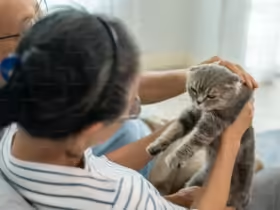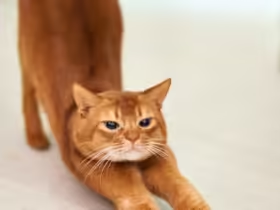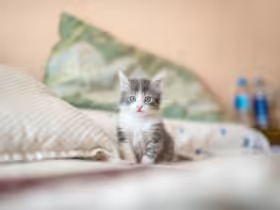Caring for a kitten diagnosed with Wobbly Kitten Syndrome, also known as Cerebellar Hypoplasia (CH), presents unique challenges and rewards. Understanding this condition and implementing the right care strategies can significantly improve the quality of life for your feline friend. This guide will provide you with detailed insights into Cerebellar Hypoplasia and offer practical advice on how to support your wobbly kitten.
What is Wobbly Kitten Syndrome?
Wobbly Kitten Syndrome refers to a neurological condition caused by the underdevelopment of the cerebellum, a part of the brain responsible for coordination and balance. Cerebellar Hypoplasia (CH) is typically congenital, meaning it is present from birth and results from the mother cat contracting certain infections during pregnancy, most commonly panleukopenia.
Symptoms of Cerebellar Hypoplasia
Kittens with CH exhibit a variety of symptoms, including:
- Wobbly or Unsteady Gait: The most noticeable sign is the kitten’s inability to walk in a straight line. They may appear to wobble or stagger.
- Head Tremors: Their head may shake or bob uncontrollably.
- Difficulty with Fine Motor Skills: CH affects the kitten’s ability to perform precise movements, such as playing with toys or climbing.
- Involuntary Movements: Some kittens may exhibit jerky or abnormal movements.
Despite these challenges, CH is a non-progressive condition. This means that while the symptoms can be severe, they do not worsen over time, and affected cats can lead happy, fulfilling lives with appropriate care.
Diagnosing Cerebellar Hypoplasia
If you suspect your kitten has Cerebellar Hypoplasia, a veterinary visit is crucial. The diagnosis is primarily based on the clinical signs observed and the kitten’s history. Your vet may also conduct tests to rule out other conditions that might present similar symptoms.
Diagnostic Steps
- Physical Examination: Your vet will assess the kitten’s coordination and balance.
- Medical History: Information about the mother cat’s health during pregnancy can be helpful.
- Additional Testing: In some cases, further tests such as blood work or imaging may be conducted to exclude other neurological disorders.
Caring for a Kitten with Cerebellar Hypoplasia
While CH does not have a cure, with proper care, affected kittens can thrive. Here are some key strategies to help your wobbly kitten live a comfortable and happy life:
1. Create a Safe Environment
Kittens with CH are prone to falling and getting into accidents due to their lack of coordination. To minimize risks:
- Use Soft Bedding: Provide cushioned areas where your kitten can rest and avoid injury from falls.
- Kitten-Proof the Space: Remove sharp objects and hazardous items that could cause injury.
- Low Obstacles: Ensure that furniture and other obstacles are low to the ground to prevent accidents.
2. Modify Your Home
- Non-Slip Surfaces: Use rugs or non-slip mats to help your kitten maintain traction on slippery floors.
- Accessible Resources: Place food, water, and litter boxes in easily accessible areas so your kitten doesn’t have to navigate complex terrain.
3. Encourage Exercise and Play
Regular, gentle exercise is essential to help your kitten develop muscle strength and coordination:
- Interactive Toys: Use toys that are easy for your kitten to bat around and grab.
- Gentle Play: Engage in play that encourages movement without overexertion.
4. Monitor and Support Feeding
Some kittens with CH might have difficulty eating due to coordination issues:
- Elevated Dishes: Use elevated feeding dishes to make it easier for your kitten to reach their food.
- Assist Feeding: Be prepared to assist with feeding if necessary, either by hand-feeding or using specially designed dishes.
5. Regular Veterinary Check-ups
Ongoing veterinary care is important to monitor your kitten’s health and development:
- Routine Visits: Schedule regular check-ups to ensure that your kitten’s condition is stable and address any potential health issues.
- Vaccinations and Preventative Care: Keep up with vaccinations and other preventative measures to maintain overall health.
6. Provide Emotional Support
Kittens with CH often require extra attention and patience. Providing emotional support can help them adjust to their condition:
- Gentle Handling: Be gentle and supportive when interacting with your kitten.
- Positive Reinforcement: Use treats and praise to encourage desired behaviors and build confidence.
Living with a Kitten with Cerebellar Hypoplasia
Living with a kitten who has Cerebellar Hypoplasia can be immensely rewarding. These cats often develop strong bonds with their caregivers and exhibit unique and endearing personalities. Their wobbly movements can be charming and bring joy to their families.
Adapting to Your Kitten’s Needs
- Be Patient: Understand that your kitten’s movements may be uncoordinated, and they might need extra time to adapt to new situations.
- Celebrate Achievements: Celebrate milestones and improvements, no matter how small.
Educating Others
Educating friends, family, and potential adopters about Cerebellar Hypoplasia can foster understanding and support. Providing accurate information helps others appreciate the unique challenges and joys of living with a kitten with CH.











Leave a Reply